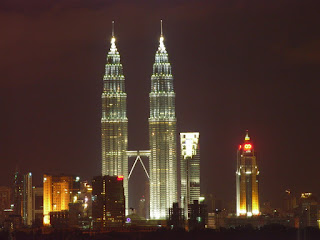Wednesday, March 11, 2009
KLCC Nightlife Guide
About KLCC
From outside, the Twin Towers look like a pair of steel pinnacles, glistering brightly under the sun but it was actually constructed primarily from super high-strength concrete. The top of each tower resembles thin minarets and both buildings are connected via a sky bridge with an inverted 'V' pillar below it. At night, the Twin Towers become brightly light like a beacon in the middle of the city.
Nestled between the towers is the popular shopping mall Suria KLCC as well as the Philharmonic Orchestra Theatre Hall and the Petrosains Discovery Centre. On the grounds fronting the towers, a well-landscaped park and garden provide refreshment and recreation for visitors and local residents of Ampang area. In this beautiful park, there are paved jogging paths, water coolers and rows of neatly-trimmed flowering shrubs and bushes.
The esplanade facing the Twin Towers has a wide fountain that incorporates a light show during the night. Programmed to provide up to 150 colourful simulations of water and light, it never fails to catch the attention of passer-bys in the area. In addition, there is a free wading pool for children in the park, a welcome respite for families after a hot day.
For visitors wanting a view from the top of the Twin Towers, the sky-bridge is open for visitors, but only to the first 1,400 people each day. The passes are free to walk the 58-meter long bridge which is open from 9am to 7pm daily, except on Mondays when it is closed
Amazing KLCC
Kuala Lumpur City Centre refers to the commercial centre located in the heart of the city that includes the Petronas Twin Towers, the Suria KLCC Shopping Mall, a park, a 5-star hotel and prime office blocks. Strategically located in the centre of Kuala Lumpur, which gives rise to its name, KLCC and the areas around it are some of the main destinations for shopping, clubbing and business for both locals and internationals.
KLCC is located within the Ampang district, which is itself a prime residential and commercial area that fetches a high value in real estate. Even its history is filled with richness; Ampang was the home of the tin barons that earned a fortune from Kuala Lumpur's mining trade. Even today, Ampang is regarded as a place for upmarket people in terms of living and spending.
Ampang is also where most of the embassies from countries such as America, the United Kingdom, France and China are located, along with a high number of expatriates living in the area. In terms of shopping, KLCC is an extremely popular area for high-class fashion and upmarket items. Many international restaurants and cafes also carpet the area, a testament to its international community. At night, Ampang and its bordering roads are popular nightspots.
Amazing Malaysia
 Amazing Malaysia
Amazing MalaysiaFlag description:
14 equal horizontal stripes of red (top) alternating with white (bottom); there is a blue rectangle in the upper hoist-side corner bearing a yellow crescent and a yellow 14-pointed star; the crescent and the star are traditional symbols of Islam; the design was based on the flag of the US
Malaysia is a federation that consists of thirteen states and three federal territories in Southeast Asia with a total landmass of 329,847 square kilometres . The capital city is Kuala Lumpur, while Putrajaya is the seat of the federal government.
Population:
25,274,132 (July 2008 est.)
Religions:
Muslim 60.4%, Buddhist 19.2%, Christian 9.1%, Hindu 6.3%, Confucianism, Taoism, other traditional Chinese religions 2.6%, other or unknown 1.5%, none 0.8% (2000 census)
Languages:
Bahasa Malaysia (official), English, Chinese (Cantonese, Mandarin, Hokkien, Hakka, Hainan, Foochow), Tamil, Telugu, Malayalam, Panjabi, Thai note: in East Malaysia there are several indigenous languages; most widely spoken are Iban and Kadazan












